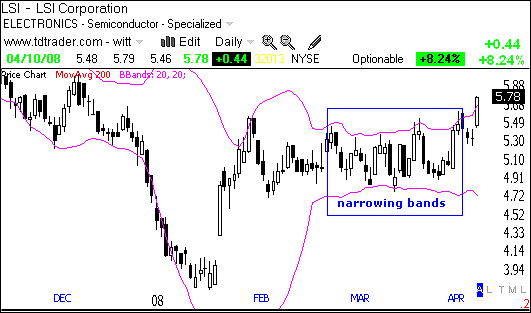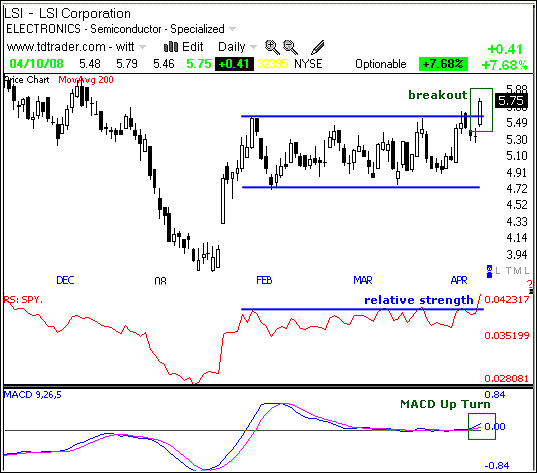
HOT TOPICS LIST
- MACD
- Fibonacci
- RSI
- Gann
- ADXR
- Stochastics
- Volume
- Triangles
- Futures
- Cycles
- Volatility
- ZIGZAG
- MESA
- Retracement
- Aroon
INDICATORS LIST
LIST OF TOPICS
PRINT THIS ARTICLE
by Arthur Hill
After a Bollinger Band contraction, LSI broke rectangle resistance, signaling a continuation of the January surge.
Position: Buy
Arthur Hill
Arthur Hill is currently editor of TDTrader.com, a website specializing in trading strategies, sector/industry specific breadth stats and overall technical analysis. He passed the Society of Technical Analysts (STA London) diploma exam with distinction is a Certified Financial Technician (CFTe). Prior to TD Trader, he was the Chief Technical Analyst for Stockcharts.com and the main contributor to the ChartSchool.
PRINT THIS ARTICLE
BOLLINGER BANDS
LSI Breaks Flag Resistance
04/10/08 09:01:17 AMby Arthur Hill
After a Bollinger Band contraction, LSI broke rectangle resistance, signaling a continuation of the January surge.
Position: Buy
| Figure 1 shows LSI Corp. (LSI) with Bollinger Bands. The upper and lower bands are set two standard deviations from the 20-day simple moving average. The bands narrow when volatility decreases and expand when volatility increases. Normally, volatility decreases during a trading range and increases on a breakout. |

|
| FIGURE 1: LSI, DAILY. Here, the upper and lower bands of the Bollinger Bands are set two standard deviations from the 20-day simple moving average. |
| Graphic provided by: TeleChart2007. |
| |
| The blue box shows a period of decreased volatility. Note that this was preceded by a period of increased volatility. Bollinger Bands do not provide any directional clues and only help to identify periods of lower volatility that can foreshadow a significant move. |
| Figure 2 focuses on the breakout. The Bollinger Bands told us that volatility was decreasing and to prepare for a potential move. The stock surged in January and then consolidated in February and March. The pattern looks like a large flag or rectangle. The recent break above the February–March highs is bullish and signals a continuation of the prior advance. |

|
| FIGURE 2: LSI, DAILY. In this chart, the breakout can be seen. The bands indicate that volatility was decreasing and that we should prepare for a potential move. |
| Graphic provided by: TeleChart2007. |
| |
| Momentum and relative strength confirm the breakout. The red indicator compares LSI to the Standard & Poor's 500 exchange traded fund (ETF)(SPY) for a measure of relative performance. There was also a surge in January and then a consolidation. The indicator broke out with the stock, and this shows relative strength. The bottom indicator shows the moving average convergence/divergence (MACD), which measures momentum. The indicator hovered around the zero line as the stock consolidated and turned up over the last few days as the stock broke resistance. Momentum is also on the way up, and this is bullish. |
Arthur Hill is currently editor of TDTrader.com, a website specializing in trading strategies, sector/industry specific breadth stats and overall technical analysis. He passed the Society of Technical Analysts (STA London) diploma exam with distinction is a Certified Financial Technician (CFTe). Prior to TD Trader, he was the Chief Technical Analyst for Stockcharts.com and the main contributor to the ChartSchool.
| Title: | Editor |
| Company: | TDTrader.com |
| Address: | Willem Geetsstraat 17 |
| Mechelen, B2800 | |
| Phone # for sales: | 3215345465 |
| Website: | www.tdtrader.com |
| E-mail address: | arthurh@tdtrader.com |
Traders' Resource Links | |
| TDTrader.com has not added any product or service information to TRADERS' RESOURCE. | |
Click here for more information about our publications!
Comments
Date: 04/10/08Rank: 5Comment:
Date: 04/29/08Rank: 5Comment:

|

Request Information From Our Sponsors
- StockCharts.com, Inc.
- Candle Patterns
- Candlestick Charting Explained
- Intermarket Technical Analysis
- John Murphy on Chart Analysis
- John Murphy's Chart Pattern Recognition
- John Murphy's Market Message
- MurphyExplainsMarketAnalysis-Intermarket Analysis
- MurphyExplainsMarketAnalysis-Visual Analysis
- StockCharts.com
- Technical Analysis of the Financial Markets
- The Visual Investor
- VectorVest, Inc.
- Executive Premier Workshop
- One-Day Options Course
- OptionsPro
- Retirement Income Workshop
- Sure-Fire Trading Systems (VectorVest, Inc.)
- Trading as a Business Workshop
- VectorVest 7 EOD
- VectorVest 7 RealTime/IntraDay
- VectorVest AutoTester
- VectorVest Educational Services
- VectorVest OnLine
- VectorVest Options Analyzer
- VectorVest ProGraphics v6.0
- VectorVest ProTrader 7
- VectorVest RealTime Derby Tool
- VectorVest Simulator
- VectorVest Variator
- VectorVest Watchdog
